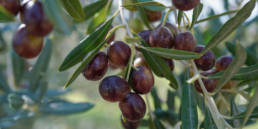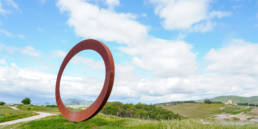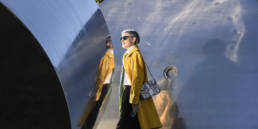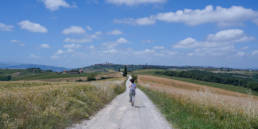Those Etruscans sure knew how to pick the best locations! In Maremma, Tuscany, there are numerous Etruscan and Roman archaeological sites in an area that is now perfect for tourism – vast landscapes producing lots of fresh food, and a short drive to blue-flag beaches and parkland. Personally, I find it hard to spend a week’s holiday by the sea without at least a little bit of culture. Archaeological sites are a good option, often providing good views and an opportunity to go for a walk. As it can get hot, it’s best done first thing in the morning or towards closing time in the evening. Here are five beautiful archaeological sites in Maremma, in order from south to north.
Populonia

The only Etruscan settlement directly on the sea, Populonia is as good as it gets. The Etruscans set up their town on the peninsula of Piombino on a hill overlooking this stunning bay of Baratti on the Tyrrhenian sea. This is the largest Etruscan necropolis in all of Italy, with tombs that represent all the shapes and types in use over the years. There are upper and lower areas to explore – if your time is limited, aim for the more concentrated top part, which has better views. The modern town that grew up next to the necropolis features a 15th-century castle made of stones stolen from the Etruscan ruins.
Vetulonia

If Castiglione della Pescaia is your beach of preference, Vetulonia is the closest dig. About 20 minutes inland from the famous beach destination is the modern hill-town of Vetulonia, and on the road up to it, you’ll find the archaeological area, a necropolis that dates to the 7th century BCE. As Vetulonia, like many sites in Maremma, is still an active dig, you may see people at work, or witness a new discovery! In 2010, a well preserved Etruscan Domus was found here, the first of its kind to be discovered intact. Almost everything we know about the Etruscans comes from tombs, not from domestic architecture.

If driving up the road, the entrance to the main area is on the left, but a little bit back down the road, on the right side, there’s a dirt road off which some more tombs are located (and they’re free to visit!).
Roselle

The via Aurelia was built in 241 BCE to connect Rome to Pisa. Now Strada Statale 1, you can feel the history at 90km/h. At the Grosseto Sud exit is the Etruscan city of Rossellae (now Roselle), established in the 7th century BCE and taken over by the Romans in 294 BCE. The Romans “incorporated” rather than killed off the population, so Etruscan workmanship, style and even traditions can be found in the later structures of the area. One of the best preserved areas is the “House of the Mosaics” where, from the layout and the bit of decoration that remains, you can get a sense of the shape of a rich Roman house. There is also an impressive ampitheatre where events are held in the summertime. By Italian standards, the signage at this archaeological area, while aging, provides useful information. Read my article about Roselle on TuscanyArts.
Sovana-Sorano

Sovana, a visit best paired with the tufa town of Pitigliano, is famous for its vie cave, amazing Etruscan roads that were carved out of the relatively soft tufa stone. Walk though these narrow stone openings with walls that reach ten meters high and marvel at how they made this road without any mechanical tools! The permanent shadow makes this a good place for a summer walk, and also favours the growth of unusual types of lychens and ferns. Due to heavy rains in Maremma in 2012, some of the area is closed for restoration. (Read my article on the vie cave on TuscanyArts)

Through the park’s circuit there are also a number of Etruscan necropoli. The most famous is the very large Tomb of Hildebrand, named not for who was buried there but for an 11th-century pope (Gregory VII) who was from Sovana. It was discovered in 1924. Cut directly out of the tufa stone, the elaborate tomb facade denotes a large burial chamber. Hard to imagine now, it was fully painted in bright colours and had numerous decorative elements that were already lost when the tomb was raided in Ancient times.
Vulci

Over the border into Lazio, this large archaeological park boasts mostly Roman ruins. It’s greener than many other parks, making it particularly pleasant to look at, though not very shady. For a good history of this park – and a good argument for why you should visit – check out this article on the blog Minor Sights.
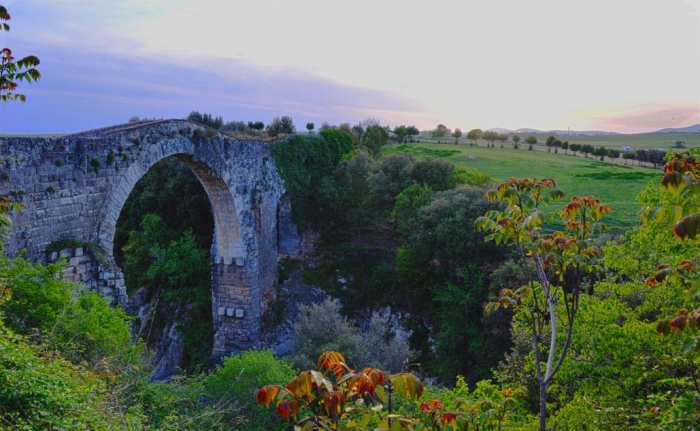
We headed south to Vulci one day when I was looking at the Fiora river on a map and wanted to follow its path in person (there are a few interesting things to see along the way!). I had read that there was a “Devil’s bridge” here. It’s not the only bridge in Tuscany (or Lazio) to be attributed to the work of the Devil, since in the middle ages, when this bridge was probably built (in its first incarnation), it must have seemed like an impossible, magical feat. In fact it still does today, especially if you visit at sunset. The bridge is accessed by continuing inland by car after visiting the archaeological site.
Map of sites
Sign up to receive future blog posts by email
Alexandra Korey
Alexandra Korey aka @arttrav on social media, is a Florence-based writer and digital consultant. Her blog, ArtTrav has been online since 2004.
Related Posts
November 17, 2021
My favourite suppliers of Tuscan olive oil
May 20, 2021
Volterra: Art, Wine and Minerals
January 17, 2021

